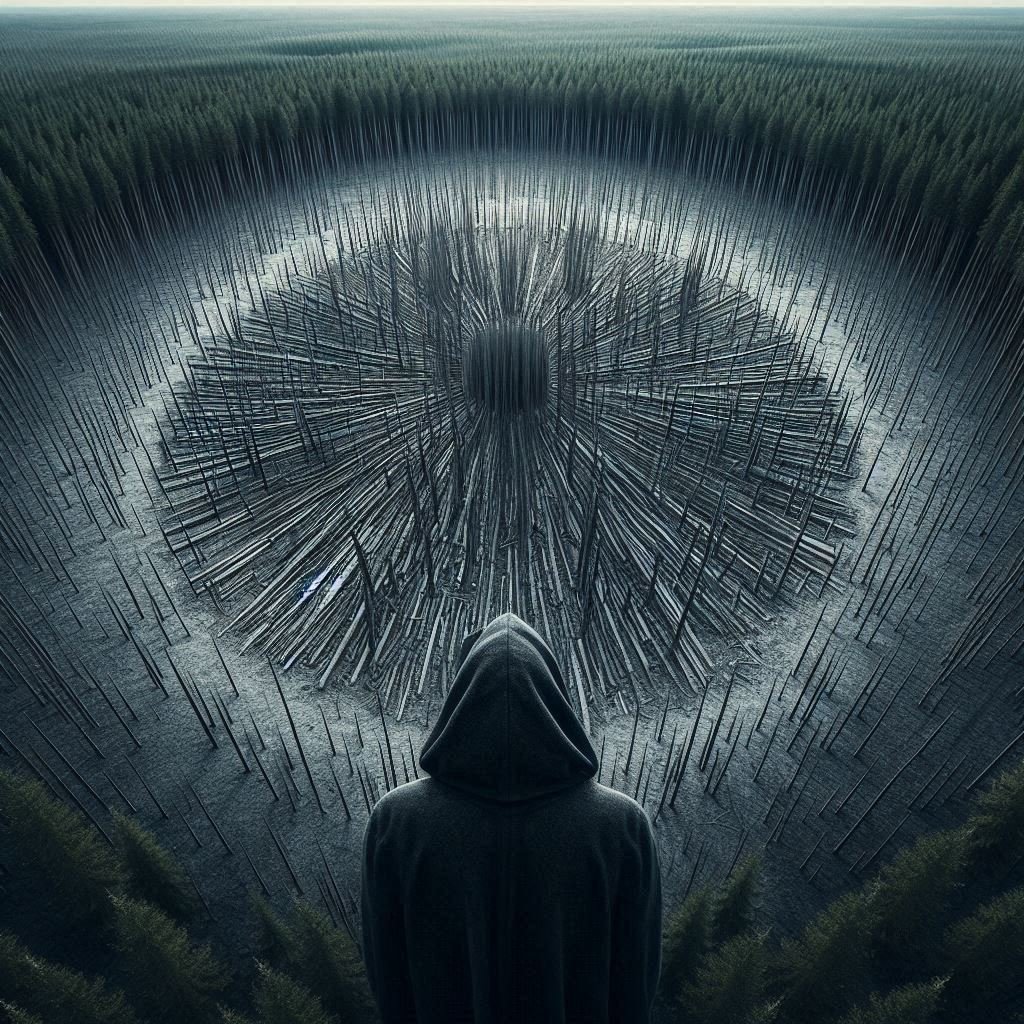Imagine you’re standing in the middle of a forest in Siberia on a quiet summer morning. The air is cool, the trees stretch endlessly in every direction, and the world feels still. Then, without warning, the sky tears apart with a deafening roar. A blinding flash, brighter than the sun, lights up the horizon. Seconds later, an explosion rips through the land with the force of hundreds of atomic bombs. Trees are snapped like matchsticks. The earth trembles. People are thrown to the ground, even though they live miles away.
This isn’t science fiction. This really happened.
On the morning of June 30, 1908, a massive explosion ripped through a remote part of Siberia near the Tunguska River. In a matter of seconds, 80 million trees were flattened across more than 800 square miles of forest. That’s an area bigger than some small countries.
And yet, more than 100 years later, no one can say for certain what caused it.
This is the strange, dark, and mysterious story of the Tunguska Event.
The Morning the Sky Fell
The day started like any other in the remote Siberian wilderness. The people who lived there were mostly reindeer herders and hunters. Life was quiet, hard, and far away from the rest of the world. But at 7:17 a.m., that quiet was destroyed.
A fireball streaked across the sky, so bright it could be seen hundreds of miles away. Witnesses described it as a second sun. Some said it was blue-white, others fiery red. The air grew hot. Dogs howled.
Then came the explosion.
The shockwave flattened trees in every direction, radiating out from a central point. Later, when scientists finally reached the site, they discovered something eerie: all the trees in the middle of the blast zone were scorched but still standing upright, while the trees further out were blown down flat, all pointing away from the center. It looked like a giant hand had slammed into the forest.
In nearby villages, people were knocked off their feet. Windows shattered. Some reported a wave of heat so intense it burned their skin. Others thought the end of the world had come.
And then, just as suddenly, it was quiet again.
The Mystery
When the dust settled, there was devastation but no crater. That’s what confused everyone.
Normally, when something this powerful happens—like a meteor hitting the Earth—you expect to see a giant hole in the ground. But at Tunguska, there was nothing. No crater. No chunks of rock. Just a scorched forest flattened in a butterfly-shaped pattern.
It was as if the sky itself had exploded.
For decades, this left scientists scratching their heads. What could release so much energy without leaving a trace?
The First Investigators
It wasn’t until 1927, almost twenty years later, that the first scientific expedition made it to the site. A Russian scientist named Leonid Kulik led the team. Getting there was nearly impossible—Siberia is harsh, remote, and full of swamps, rivers, and endless forest. But Kulik had heard rumors of the explosion and was determined to uncover the truth.
When he and his team arrived, what they saw stunned them. The trees were still lying flat in perfect patterns, all pointing away from a central point like the spokes of a wheel. But there was no crater, no giant meteor, nothing but scorched earth.
Local hunters told Kulik terrifying stories. They spoke of a fireball in the sky, of thunder that lasted for minutes, of animals dropping dead. Some claimed the ground shook for days afterward.
Kulik believed a giant meteor had exploded in the atmosphere before hitting the ground. That would explain the massive shockwave but not the missing crater. Still, it was the best theory he had.
But there was one more strange twist: people all across Europe and Asia reported seeing strange glowing skies in the days after the explosion. In London, thousands of miles away, the night skies glowed so brightly that people could read newspapers at midnight without a lamp.
Something huge had happened over Tunguska. Something the world had never seen before.
How Big Was It?
Modern scientists estimate the blast released as much energy as 185 Hiroshima bombs. Some say it was the size of a 10–15 megaton explosion—bigger than any weapon mankind had built at the time.
And it happened in one of the most remote, uninhabited places on Earth. If the Tunguska Event had happened just a few hours later, when Earth had rotated slightly more, the explosion might have wiped out the city of St. Petersburg, which had over a million people.
In that sense, the Tunguska Event was both a disaster and a miracle.
The Theories
So, what actually hit Tunguska?
For more than a century, scientists, writers, and conspiracy theorists have fought over the answer. And the theories range from reasonable… to absolutely bizarre.
The most widely accepted explanation is that a space rock—a comet or asteroid—entered Earth’s atmosphere and exploded before hitting the ground. This would be called an airburst.
The idea is that the rock hit the thick layers of atmosphere at such high speed that the friction caused it to heat up and explode mid-air, releasing a fireball and shockwave without leaving a crater.
It makes sense. In fact, scientists believe the Tunguska explosion was caused by a rock about 150–200 feet wide, moving at 33,000 miles per hour. When it exploded about 5 miles above the ground, the blast was catastrophic.
But not everyone is convinced.
The Stranger Theories
Some researchers argue that it wasn’t a rock at all, but a comet made of ice. A comet would have vaporized in the atmosphere, leaving no trace, which could explain the missing crater.
Others suggest it might have been a small black hole passing through Earth. Imagine a chunk of collapsed star, so dense it bends space around it. If a black hole had punched through our planet, it would release enormous energy. But the idea doesn’t hold up—there’s no evidence of a hole on the opposite side of Earth.
Then there are the more out-there theories:
-
Some claimed it was an alien spaceship that exploded over Siberia. In fact, a few writers in the Soviet Union pushed this idea in the 1960s.
-
Others suggested it was a secret nuclear experiment, though this happened decades before nuclear weapons were invented.
-
A few even believed it was caused by Nikola Tesla, the eccentric inventor, testing a massive energy weapon from halfway around the world. Tesla had been experimenting with wireless electricity at the time, and some think he accidentally zapped Siberia.
Most scientists dismiss these ideas. But the truth is, no one can say for certain.
More Clues
Over the years, more expeditions studied the Tunguska site. They found tiny glass-like particles in the soil, called microspherules, which are often linked to meteors. Some tree resin samples also contained rare isotopes, suggesting an extraterrestrial origin.
In 2007, a group of Italian scientists claimed they found the remains of a crater hidden under a lake near Tunguska, called Lake Cheko. They argued that the lake was formed when a chunk of the meteor crashed into the Earth.
But other experts disagreed, saying Lake Cheko had existed long before 1908.
Even with modern technology, the mystery remains unsolved.
Why It Matters
You might wonder—why does something that happened over 100 years ago in a remote forest still matter today?
Because Tunguska is a reminder of how vulnerable we are.
Space rocks are out there, orbiting the sun, crossing Earth’s path every day. Most are tiny and burn up harmlessly in the atmosphere. But some are big enough to do real damage.
In fact, in 2013, a smaller version of Tunguska happened in Chelyabinsk, Russia. A meteor exploded in the atmosphere with the force of 30 Hiroshima bombs. The shockwave shattered windows across the city, injuring over a thousand people. Luckily, no one died. But it showed us that Tunguska wasn’t a one-time event.
If another rock the size of the Tunguska object were to explode over a major city today, the results would be catastrophic. Millions could die.
That’s why scientists around the world are now tracking near-Earth objects, trying to spot threats before it’s too late.
The Enduring Mystery
The Tunguska Event remains one of the greatest scientific mysteries of the 20th century. We know something massive exploded. We know it leveled forests and lit up the skies around the world. But the exact details—the “what” and the “how”—are still debated.
Somewhere between science and legend, between comet and asteroid, between fact and speculation, lies the truth.
And maybe that’s what makes Tunguska so fascinating. It’s not just a story about an explosion. It’s a story about the limits of human knowledge, about how nature still holds secrets bigger than we can imagine.
Standing in that forest today, more than a century later, the trees have regrown. Life has returned. But from above, you can still see the strange, circular scars in the landscape—the ghostly fingerprint of a cosmic visitor.
And every year, on June 30th, scientists and sky-watchers around the world remember the day the sky fell on Tunguska.
Closing
So, what hit Tunguska?
Was it a comet? An asteroid? Something stranger, like an alien ship or Tesla’s death ray?
We may never know for sure. What we do know is that on one summer morning in 1908, Earth got a terrifying wake-up call. A reminder that we live on a planet in a cosmic shooting gallery, surrounded by objects that could, at any moment, change everything.
The Tunguska Event is not just history—it’s a warning. A century-old mystery that still whispers to us today:
The sky can fall. And when it does, there may not be a crater to prove it.
That’s the strange, dark, and mysterious story of the Tunguska Event—a century-old puzzle that still keeps scientists, and storytellers, awake at night.




